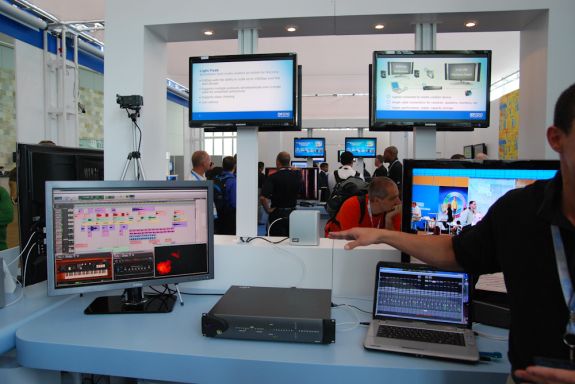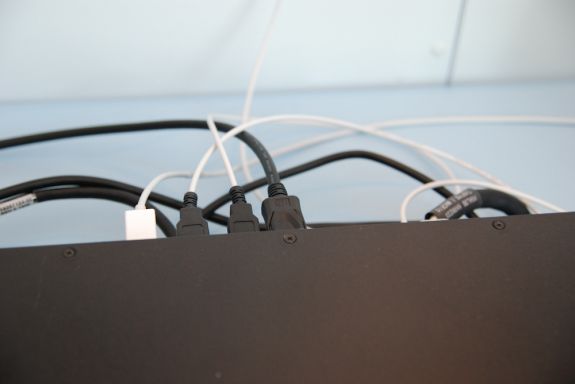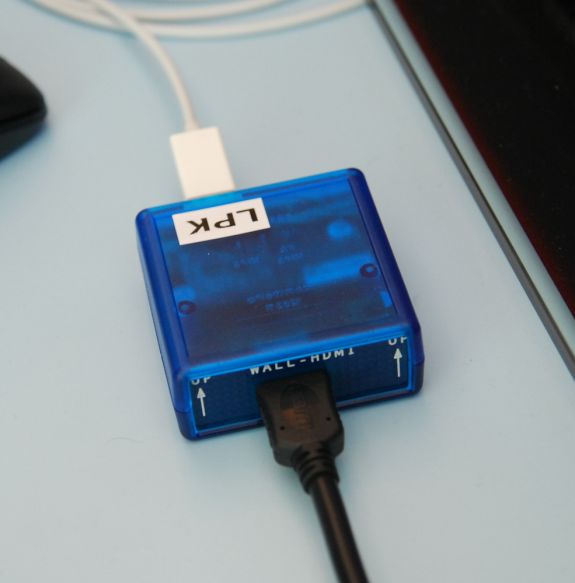Intel Light Peak - Lighting up 10 Gbps links in 2011
by Brian Klug on September 16, 2010 3:40 PM EST- Posted in
- Trade Shows
- Intel
- LightPeak
First off, Light Peak speeds remain the same as we've previously seen at 10 gigabits/s, though opportunity to scale to 100 gigabits/s remains a promise for the future. Intel had two demonstrations setup illustrating Light Peak's potential as a bus for huge amounts of traffic. First up was a Compal notebook connected to an Avid HD I/O box, which was in turn connected to two more devices. An external Western Digital dual drive solution with a Light Peak connector, and an HDMI adapter driving 1080P video content.
According to Intel, Light Peak enabled Avid to move mixing control to the Compal notebook software suite. Bandwidth is now sufficient to pass uncompressed extremely high sampling rate audio streams between the notebook and the Avid HD I/O box.
All of those white cables coming out of the Avid box on the left side are Light Peak. Note that they look a lot like USB - more on that in a moment. Light Peak connects the Avid HD I/O box and its lossless audio streams, a raw 1080P HDMI video stream, Western Digital external hard drive, and another uncompressed video played back on the Dell LCD to the left in this demo. This demo is clearly targeted at selling studio artists on Light Peak.
The Light Peak to HDMI converter box has also shrunk considerably. It's now a bit smaller in profile than a credit card:
There's no external power adapter here either, just Light Peak to HDMI for the TV. The Compal notebook has been shown around a bit before, but the connection is again seamlessly integrated into the notebook by all appearances. Check out the gallery for all the pics from this demo:



















59 Comments
View All Comments
Jaybus - Friday, September 17, 2010 - link
The first generation LP will have competition from USB 3. For one thing, USB 3 is instantly backward compatible with the huge installed base of existing USB 2 devices. LP would need some sort of adapter and AFAIK doesn't provide power. So USB 3 will be much cheaper and at 10x the USB 2 bandwidth will seem "fast enough" for a few years.The big question, right now, is not Intel working LP into a chipset, or even into a SoC, but rather what about the device interface chip? Can drive makers selling $80 USB drives add a LP interface, or does that make the $80 drive a $120 drive? The USB 3 will already transfer data far faster than the drive can keep up with. The LP device interface chip has to be cost cometitive with the USB 3 chip.
However, I see the big move coming. When their integrated photonics stuff gets rolling, the cost of LP will dramatically fall. There is no question that the LP bandwidth has much room for growth, while any copper cabling system has near zero room for growth. Optical transmission is definitely the future, but the cost has to come down and something has to be done about supplying power for external devices.
wwwcd - Friday, September 17, 2010 - link
M$ not have possibilities to make a world size standart of comunication , if they come out of full support of the other biggest trademark in this industry!FXi - Friday, September 17, 2010 - link
Fails to deliver power over the connection. Thus ultimately it is about 1/10th as useful to the general population who will vote for simplicity over speed. USB 3 gives you both speed and power and will be multiples more useful.Pwnx0r - Friday, September 17, 2010 - link
There's going to be a copper wire in the cable for power.boden - Saturday, September 18, 2010 - link
One cable to rule them all,One cable to find them,
One cable to bring them all
and in the light, bind them.
Casper42 - Saturday, September 18, 2010 - link
If they can keep this stuff relatively cheap, the 50m Distance along with the ability to Daisy chain for longer distances means this would make a pretty decent Home Networking medium.How would you like to have 10GE strung around your entire house?
Or for that matter, take your HDD out of your desktop and have it in the basement.
Or hell, LPK enabled Monitor and leave the entire PC in the basement.
Can't wait to see what level they take this to and I pray they keep it fairly cheap.
ABR - Monday, September 20, 2010 - link
"obviously the connector will be subject to the same kind of scrutiny that USB was for durability and consumer friendliness"I hope not! While definitely nicer than old-style long-pin connectors, trying to plug a USB connector in without squinting at it and the plug fails half the time due to being upside down. Hope they can take a clue from Firewire-400 here.
bobbozzo - Monday, September 20, 2010 - link
One thing I haven't seen mentioned is if LP controllers will use DMA... this would be a big advantage over USB.Bob
Hrel - Wednesday, September 29, 2010 - link
"but the display itself was only 1080p"? WTF? You guys are really starting to piss me off. Resolutions over 1080p are useless for most people, many people still don't even have 1080p on all their screens. Also, I see almost no point in going to 1440p or 1600p, it's not going to be enough to make a noticeable difference; diminishing returns and all. Let the world catch up to 1080p, then, sometime around 2020, we can start getting excited about 16,160X9,090 ie 9090p or whatever becomes the next big step. Quite frankly 4320p isn't enough to convince me to spend any extra money, I'd still wait for a 37" to drop down under 500 bucks. 3D and stupid widgets I'll never use and all. /rant.